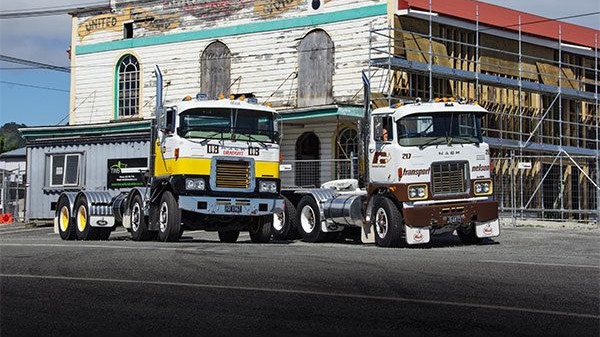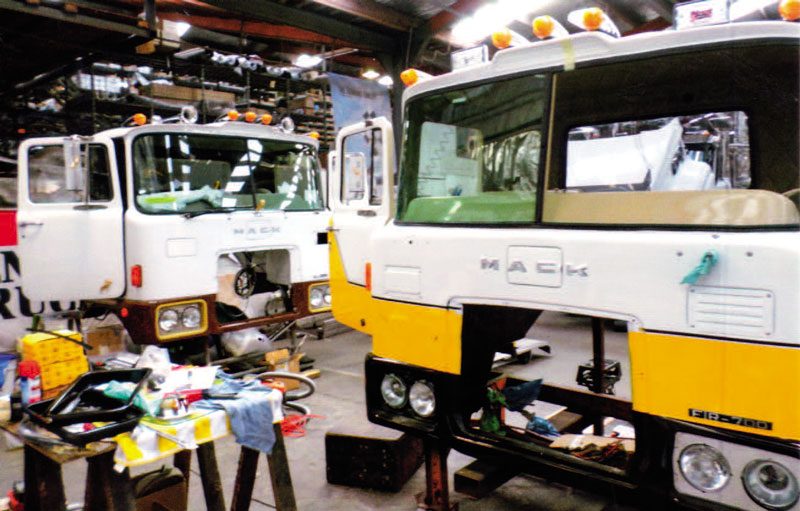
The Mack FR Series entered New Zealand’s heavytruck market in 1972, going toe-to-toe at the business end of the United States cabover truck market with Kenworth’s K-Series.
Click here to watch these beauties in action!
Some 148 F Models rolled out the door of Motor Truck Distributors’ Palmerston North assembly plant between 1972 and 1984. They went to operators from the Deep South to the Far North and were involved in almost every sphere of the industry, from linehaul tractor units to logging trucks. They were even employed as crash fire-tenders at virtually every major New Zealand airport during the late 1970s.
Murray Bruning served his time as a diesel mechanic at two of the South Island’s most respected trucking fleets of the period, Irvines Freightlines and Transport (Nelson) Ltd (TNL). Post-apprenticeship he also worked as a driver at TNL.
 1) The arrival home from Oxford in Canterbury.
1) The arrival home from Oxford in Canterbury.
 2) Always phase one, cleaned thoroughly and cab off.
2) Always phase one, cleaned thoroughly and cab off.
Irvines ran a significant fleet of R-Model Macks, and one company FR. TNL, on the other hand, had a number of both variants. In his combined tenures, Murray amassed valuable experience, both on the spanners and behind the wheel of each iconic model.
As an interesting aside, TNL was the first South company to run multiple examples of both Mack and Kenworth, as we intimated above, the two great rivals of the era.
A desire to preserve some history from the era and a chance conversation about a former TNL Mack FR sitting derelict in North Canterbury led to what can only be described as two of the best Mack truck restorations in the country. They were undertaken by Murray and his good mate, Les Hayden.
 3) Separate the rails. 4) Primed. The journey back begins.
3) Separate the rails. 4) Primed. The journey back begins.
TNL Fleet 217
Both trucks began their lives in the iconic TNL fleet. Fleet No.217, owned by Murray, is a 1978 FR786RST powered by a Mack ENDTB676 Maxidyne engine, producing 285hp and fitted with Mack’s TRDL1070 Maxitorque 10-speed transmission.
Its working life began running double-shift, carrying general freight predominately between Nelson and the Spring Creek railhead (north of Blenheim).
Thirty-two years later, the truck was located parked up in the long grass near Oxford in North Canterbury. Its most recent work had been in building removals.
 5) The drive assembly complete and in search of a couple of rails.
5) The drive assembly complete and in search of a couple of rails.
 TNL fleet number 217, like Steve Austen the six-million-dollar man – better than it was before!
TNL fleet number 217, like Steve Austen the six-million-dollar man – better than it was before!
The truck had spent the thick end of a decade in the open, so its overall condition couldn’t be described as great. But everything was there and a deal was completed. After that, No.217 was transported across the Southern Alps to Greymouth, where its restoration began.
After a thorough clean, the strip-down commenced. Its cab was removed, and all driveline componentry was stripped from the chassis.
Both chassis rails were separated, blasted, and re-painted to remedy some corrosion, while the engine and gearbox were completely rebuilt using all new components. Both diffs had new bearings installed, and the trunnion on the Mack Camelback rear suspension was overhauled. Completely new braking componentry and wheel bearings were fitted right around.
The truck had left the Malden Street factory fitted with very distinctive Farr external air cleaners, replaced by a pair of Donaldson versions in the ensuing decades.
A Farr system was sourced from a donor truck in Southland and a replica of the original framework they were mounted on had to be constructed from scratch using only photographs for reference.
 1) Fresh back from Palmerston North.
1) Fresh back from Palmerston North.
 2) Murray’s dash mid-restoration.
2) Murray’s dash mid-restoration.
Attention then turned to the cab. The original upholstery was stripped, seats removed, and the dashboard taken out.
As it was made of steel, the cab needed a substantial amount of rust removal before sandblasting and painting could take place.
Cracks in the dash were repaired, it was re-painted, and all gauges were either overhauled or replaced.
New glass was fitted before the cab was trucked to Palmerston North to have a perfect re-creation of the original upholstery fitted.
Back in Greymouth, the cab was re-fitted to the chassis and final assembly took place.
 3) The Reinforced Plastics serial plate for No.26’s cab.
3) The Reinforced Plastics serial plate for No.26’s cab.
 4) Bringing the cabs back to life, fiddly but rewarding.
4) Bringing the cabs back to life, fiddly but rewarding.
 5) Fleet 217’s cab sits complete. Photos: Bruning collection.
5) Fleet 217’s cab sits complete. Photos: Bruning collection.
Transport (Nelson) Ltd’s period signwriting was applied by Steve Foote.
The entire restoration was done as a ‘spare-time’ project. It absorbed nine years’ worth of Saturdays, plus countless amounts of public holidays and annual leave.
When it came to any big task on the rebuild project, Murray and Les had the motto: ‘Don’t walk away halfway through it. Finish it.’
Murray is quick to praise his wife Lynette for her patience and the support of his family, all of whom were frequent visitors to the workshop as the rebuild took place.
No.217 is now pretty much as it went on the road in 1978, apart from a change in tyre size from 1000×20 to 11R 22.5 to allow for slightly better road speed, a new sun visor, and an extra air horn.

 The engine in-chassis (top) and mid-restoration (below).
The engine in-chassis (top) and mid-restoration (below).
TNL Fleet No.26
No.26, owned by Les Hayden, is a 1975 A8FR785RST running a 237hp ENDTB675 Maxidyne engine and fitted originally with a 12-speed TRTXL 1070 Maxitorque transmission, replaced early in the truck’s life with a 10-speed box.
Fitted with Transport (Nelson) Ltd’s signature drop-down sides, and a matching trailer, No.26 went to work on what was known as the ‘coal shift’ run, where TNL trucks hauled gypsum from Richmond to the cement works at Westport, then loaded coal from the iconic Denniston coal fields for delivery to Golden Bay Cement at Tarakohe.
Les had assisted Murray on No.217’s restoration and “ really enjoyed it”, so much so, that when presented with the opportunity to get his own truck, he leapt at the chance.
 1) The arrival home of project No.2, Les Hayden’s ex-TNL FR, one of the legendary ‘coal shift’ trucks.
1) The arrival home of project No.2, Les Hayden’s ex-TNL FR, one of the legendary ‘coal shift’ trucks.
 2) Forklifts lower once the trailer has pulled out.
2) Forklifts lower once the trailer has pulled out.
No.26 was then owned by Canterbury classic truck enthusiast Gerald Taylor, and after an inspection, a deal was done, which included a donor cab for spare parts.
Like Murray’s truck three years before, Les’ was put on a trailer and transported to Greymouth, where many hours were spent on the water blaster, cleaning it down.
Murray and Les initially planned to complete the rebuild of No.217 before starting on No.26. But a change in thinking was required when news filtered through that the sandblasting firm that did all the work on Murray’s machine was looking at closing. Their workmanship was top quality, and both men planned for No.26 to receive the same level of attention.
 3) Cleaned, partially stripped and doors off.
3) Cleaned, partially stripped and doors off.
 4) The cab carefully lifted off. The poor old truck probably thought ‘this is the end’. Little did she know, it was just the beginning!
4) The cab carefully lifted off. The poor old truck probably thought ‘this is the end’. Little did she know, it was just the beginning!
For a while, they focused their attention on No.26. The cab and drivetrain were removed from the chassis, and a non-original spare wheel carrier was cut off.
The engine underwent a complete overhaul, while the gearbox was in reasonable condition, only requiring the top section to be re-conditioned.
A complete Mack Camelback suspension assembly (originally from an R Model) was located and overhauled before being bolted back onto the chassis.
Les’ machine has the earlier-style Reinforced Plastics (RP) fibreglass cab, and at 39 years old, it was tired, requiring a lot of effort to bring it up to standard.
 Les Hayden’s FR. Originally TNL fleet No.26, but painted as a tribute to the Dominion Breweries fleet he drove for out of his home town of Greymouth.
Les Hayden’s FR. Originally TNL fleet No.26, but painted as a tribute to the Dominion Breweries fleet he drove for out of his home town of Greymouth.
Each of the steel door frames had severe rust causing the fibreglass panel on top of them to swell, so new steel was fabricated and installed before the fibreglass was replaced.
Due to corrosion, a major structural beam below the windscreen had to be replaced, and both cab mounts required re-engineering.
No.26’s cab also made the pilgrimage back to its birthplace of Palmerston North. The RP cab had a very basic level of trim when new, but Les elected to have it fully upholstered like the latter model FRs.
Back in Greymouth, a New Zealand-designed cab suspension, complete with shock absorbers, was located, overhauled, and fitted to improve the ride.
Les spent much of his truck driving career with Dominion Breweries, working out of the former Greymouth brewery. As a tribute, he had No.26 painted in the DB livery of his era.

 From top: One of the greatest truck engines ever built? The 237hp Maxidyne engine out of No.26… before and after.
From top: One of the greatest truck engines ever built? The 237hp Maxidyne engine out of No.26… before and after.
A replica of the horizontalstyle original grille was installed, bullet lights and air horns have been fitted, and a vertical chrome exhaust contrasts the yellow and white cab nicely.
Murray and Les say they got an incredible amount of enjoyment from working on both trucks. There was a steady stream of interested visitors to the workshop over the nine years while the restorations took place. Since completion, a number of the former Transport (Nelson) Ltd staff, some of who drove the actual trucks, have also visited to see the finished result, much to the duo’s delight.
ROLL OF HONOUR
Murray and Les are quick to acknowledge that the projects would not have been achievable if not for the support and assistance they received. They wish to thank the following for their contribution to the project:
Ron Carpenter, Murray Sowerby, Brett ‘Cookie’ Cooksley and the team (Motor Truck Distributors)
David Beech, Pat O’Connor and Marc Winterburn (Truck Stops, Palmerston North)
Phil Frater (Truck Stops, Nelson)
David Baird (Sand Blasting)
Robbie Brown (Paint & Panel)
Steve Foote (Signwriting)
Auto Interiors (Upholstery)
Sollys Freight 1978 (Cartage)
Alan Gilman (Engineering talent)
Gregg ‘Foxy’ Stenhouse (Engineering talent)
Tony Kelly (Parts)
Gerald Taylor (Parts)
Neil Bradley (Parts)
A NOTE FROM NEW ZEALAND TRUCKING
While Craig was working on the article, Murray contacted us, asking if Craig himself could be acknowledged. “If it weren’t for Craig, it wouldn’t have happened. He knew where No.217 was, and it was him who pointed us in the direction of the owner. He’s part of the story, too. That has to be mentioned.”





